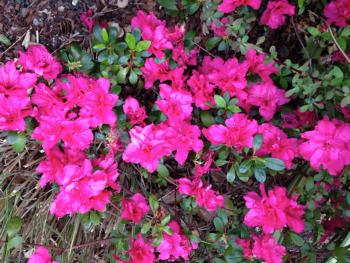Unused stories
Pest of the Month - Poisonous Plants

Carpets of lemon-yellow daffodils line walkways, clusters of plush lavender wisteria blooms drape fences and arbors, the pungent scent of daphne blossoms perfume the air, flowering apple, cherry, apricot and peaches dot the landscape with their cotton-candy pinks and creams, and those jewel-toned azaleas and rhododendrons — wow!
Most of us revel in the season’s abundant beauty without the slightest concern that these plants possess a darker side — an ability to inflict pain, sickness and even death. Evil in the garden? Who would have thought? What unwanted rogues might be skulking about in your garden?
Most homeowners aren’t familiar with the potential hazards associated with their own backyard plants and many poisonous plants are so common and seemingly innocuous you’d never suspect their toxic qualities. Plant-related poisonings ranked in the top 25 causes of poisoning in the country, with nearly 60,000 cases reported in the United States in 2009, according to the American Association of Poison Control Centers. And two-thirds of these involve children 5 years and younger.
Though exposure to poisonous plants is rarely lethal for adults, it is the fourth most
common cause of death from poisoning in kids younger than 5. Adults, pets and farm animals also can fall prey to inadvertent plant poisoning, so homeowner beware. So what is a poison? The California Poison Control System website states “a substance is toxic or poisonous if it can cause any negative symptom, even if only a mild rash.” Plants are considered poisonous if they can produce some type of negative reaction from exposure to it. Reactions can range from mild to serious, depending on the type of exposure (on the skin versus ingestion); amount of exposure; and the age, weight and health status of the patient.
The dangers that plants pose fall into four major levels or categories:
- Dermatitis: The juice, sap or thorns of these plants elicit symptoms ranging from redness, itching and rash to painful blisters such as skin burns.
- Oxalates: The juice or sap of these plants contain needle-shaped crystals that can initially irritate the skin, mouth, tongue and throat, resulting in throat swelling, breathing difficulties, burning pain, and later give rise to kidney damage as well as nausea, vomiting and diarrhea.
- Moderate toxicity: Ingestion of the plant may bring on nausea, vomiting or diarrhea but is not life-threatening.
- Major toxicity: Plants may cause serious illness (the heart, liver, kidneys or brain) or death.
The most prevalent type of poisoning is from contact dermatitis — exposure to plants that produce oxalates and other irritating substances that result in inflammation or a rash on the skin. These reactions are often associated with houseplants in the arum family (dieffenbachia, philodendron and pothos). Also known as primary irritant dermatitis, the adverse skin reaction may occur with exposure to many ornamental and edible plants: tulips and daffodil bulbs, carrot and celery leaves, the century plant (Agave), Ficus species and foxgloves.
There’s a long list of ornamental flowers, vines and shrubs that fall in the moderate or major toxicity range if ingested. The leaves of foxgloves and hydrangeas, berries of lantana, and all parts of the ubiquitous summer-blooming oleander can be deadly. And those springtime beauties? The seeds and pods of the wisteria vine can induce mild to severe digestive upset; just a few berries from the daphne plant can kill a child. Those jewel-toned azaleas and rhododendrons? Every part of the plant is highly toxic, producing symptoms of nausea and vomiting, depression, difficult breathing, prostration and coma, and can be fatal.
What’s a gardener to do to prevent plant poisoning? The California Poison Control
System recommends that you know the names of all your plants (indoors and out) and which ones are poisonous; keep all plants out of the reach of small children and, most importantly, teach children not to put any part of plants in their mouths.
“Know Your Plants!” is a free downloadable, toxic plant-rating guide from the CPC website. It lists hundreds of plants by their common and botanical names along with their toxicity level. If you suspect poisoning, the CPCS further recommends that you:
- Do not induce vomiting.
- Remove any plant parts from the mouth or hands.
- Wash around the mouth and hands and give a few sips of water.
- Check for any irritation of the skin, mouth or tongue.
- Call the California Poison Control System at 800-222-1222 (available 24 hours a day) Even if you are not sure, call the poison center for help; it will not be a waste of time.
Don’t wait for symptoms to appear — treatment will be more difficult once symptoms have developed. If you are advised to go to the hospital, take the plant or part of the plant with you. Stay safe this spring and enjoy those beautiful but dangerous plants!
Adapted from an article by Nanette Londeree published in the Marin Independent
Journal, April 2, 2011.
